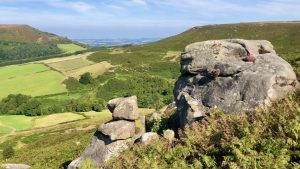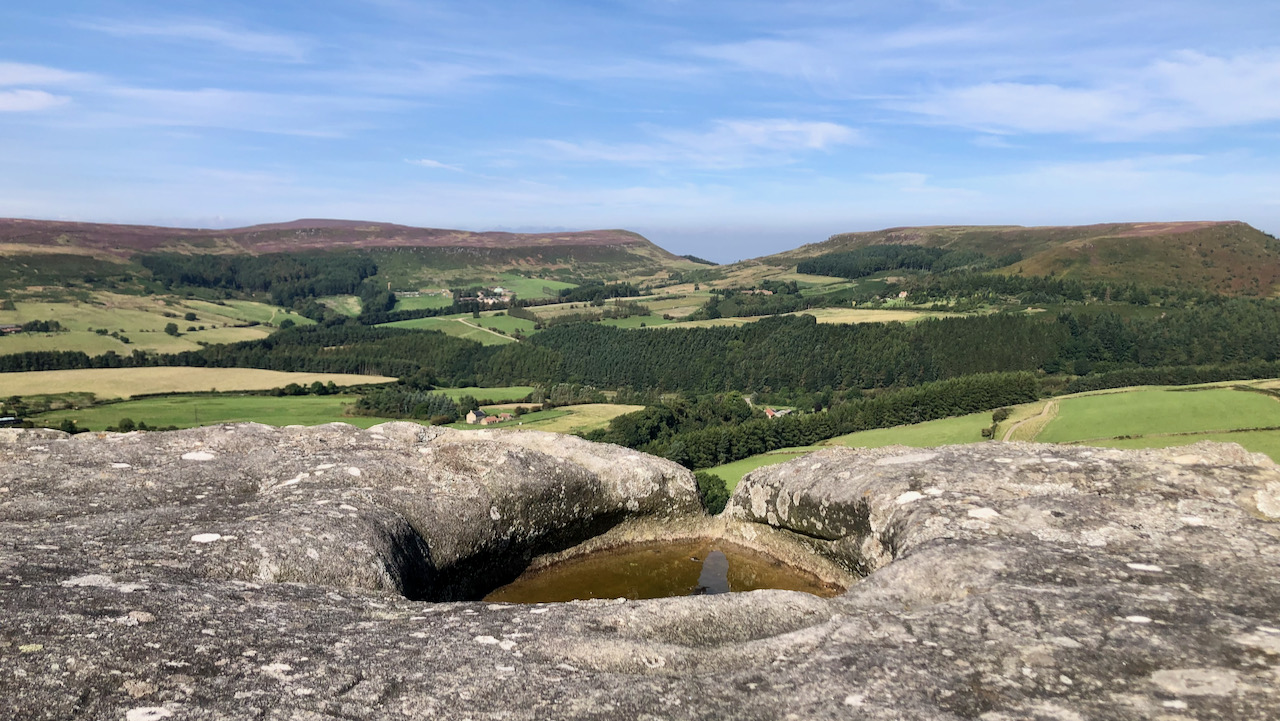I’ve been diving back into that book, “Rock Art and Ritual,” the one I got off eBay a few weeks back. It’s been giving me the itch to go revisit some of the out of the way nooks and crannies on the North York Moors.

So today, I took a little jaunt around Urra Moor, with a slight detour to check out that massive outcrop of sandstone some folks call the Cheddar Stone, but which the Ordnance Survey mapped as the Cheshire Stone on their 1857 Six-Inch map. Oh, I do like a bit of cheese. Anyway, from there, you get a clear view across Bilsdale to the Wainstones and Garfit Gap. Now, this rock’s got this big natural basin with an outflow channel running out of it. The opinion is that Prehistoric man has tampered with it to control or accentuate the water flow towards Garfit Gap1Smith, Brain A. & Walker Alan. A. “Rock Art and Ritual”. Pages 67/129. The History Press. 2011..
This evidence of this human handiwork is called “pecking” and is not the work of Mother Nature, that’s for sure. And if you squint, and with a bit of wishful thinking, you might even spot another groove and a few cups around the edge of the basin that it are also thought to bear the hand of man. Might be pure coincidence, but that flow towards Garfit Gap seems to line up with the setting sun during the Summer Solstice. The interpretation is that this means it’s something special.
Back in Prehistory, whether the water basin was natural, tweaked, or man-made, folks might not have seen it as just a ready pool of water. Maybe they thought it had some magical significance. People have always been captivated by the way water moves, from the Gardens of ancient Egypt and the Renaissance Villa d’Este to those fancy water features sold by garden centres of today. Back then, without glass or shiny metal, the reflections of the sky, clouds, and stars, plus a glimpse of your own face, must’ve felt pretty mystical. Maybe peering at your own face was a way to talk to your inner self, or to the gods. And watching rain fill those basins from above, then trickle down the rocks in predictable patterns, could’ve been like having your very own little world to control.
On the flip side, and here I risk venturing into esoteric waffle. making those water features might’ve been a way to celebrate the cosmic connection between the sky and the earth’s surface. Like a boundary between the underworld and the heavens, where sunlight, warmth, and rain, the stuff that keeps us all ticking, come together. The sun provides light and warmth, and the rain brings the water. It’s where the land meets the sky, where life gets its nourishment, and maybe that’s why Prehistoric man spent so much energy pecking away on rocky outcrops to create these water features.
- 1Smith, Brain A. & Walker Alan. A. “Rock Art and Ritual”. Pages 67/129. The History Press. 2011.

Leave a Reply